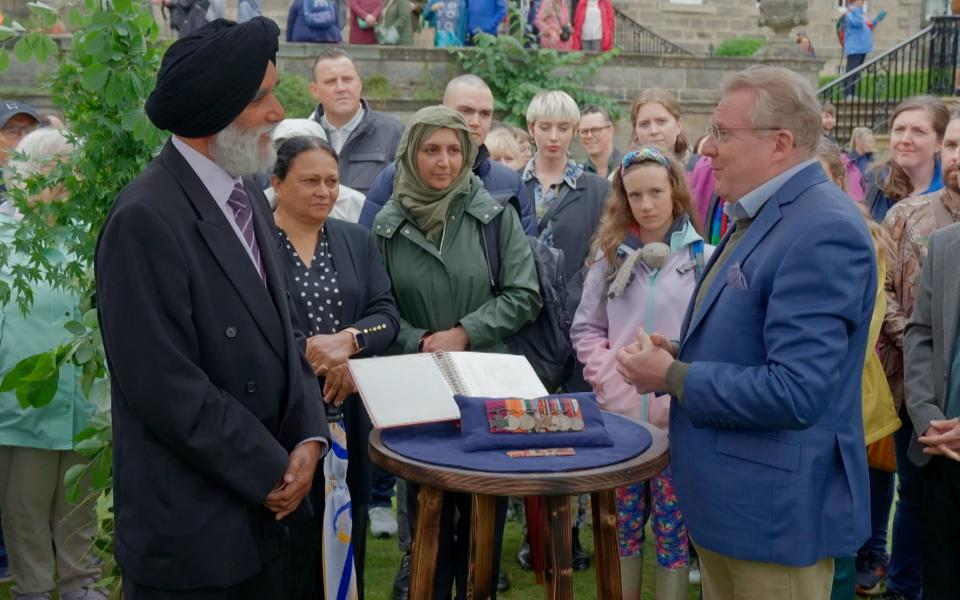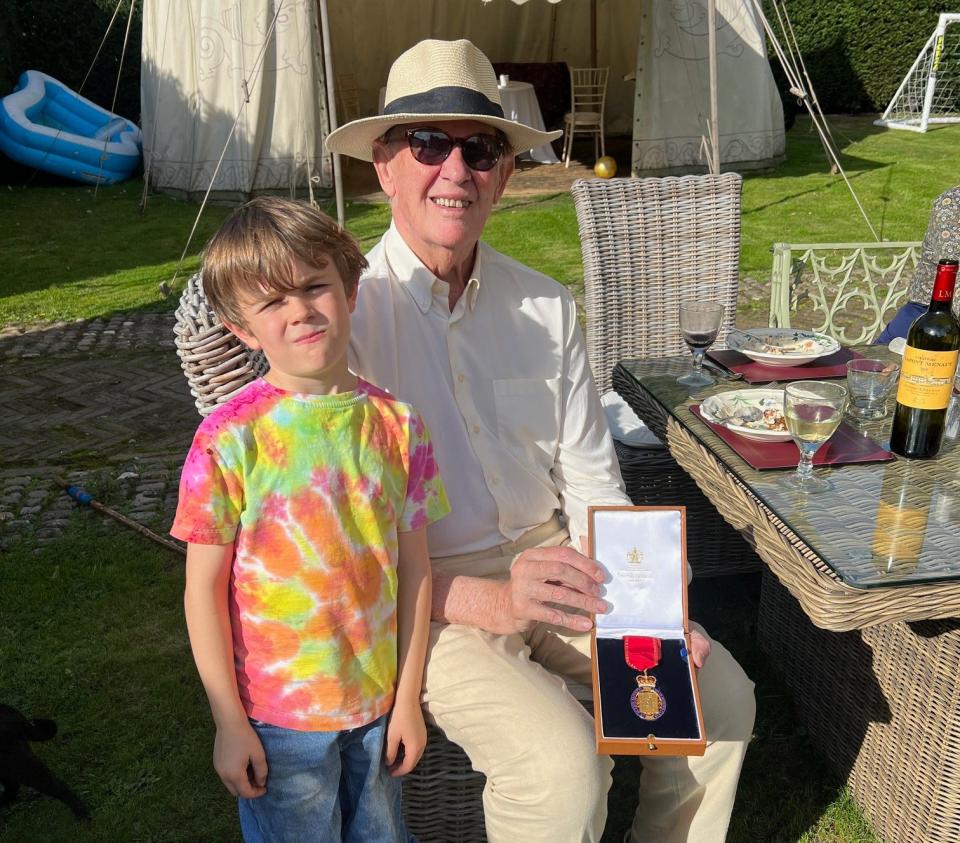I asked the Antiques Roadshow expert how much my airforce treasure was worth – I was in for a shock

Mark Smith is wearing a very RAF officer-looking burgundy silk cravat and Barbour jacket when we meet on a frosty morning on Horse Guards Parade before we walk around the Household Cavalry Museum.
Arriving from his medal office on the Strand, where – when he is not evaluating militaria for Antiques Roadshow – he works as the Orders, Decorations & Medals Expert for Baldwin’s, one of the UK’s oldest medal and coin-collecting firms.
As the Antiques Roadshow’s long-serving expert on medals, Mark is often stopped in the street and asked about family militaria that people have locked away in a drawer or attic at home. His advice is to talk about family history over Christmas and write the stories down so they aren’t forgotten. Getting out family medals is the perfect way to learn about family history.
What has made Mark into a household name is the way he has turned his passion for medal sleuthing into a Poirot form of detective work that is really about the human story and history lesson behind the medal, more than any value.
“I’m interested in the person behind the medal,” he says.

When he started out as a medal collector in 1969, there was, of course, no internet, only reference and libraries. “To find out about that person behind the medal was an incredibly difficult thing to do. But that’s where the real reward is. The family story and what a medal can reveal.”
The Antiques Roadshow is the perfect stage set for Mark to employ his walking encyclopedic knowledge of militaria. When he’s sitting at the stand for the show – only very rarely consulting a single medal reference book to double-check obscure medal details – his eyes will tend to roll over when a member of the public brings him a medal that they have bought on a well-known internet site!
A perfect example of high excitement, shared by several million viewers, was shown back in April this year when he came across the holy grail of military medals on the show, hosted at Portchester Castle.
“This is a unique moment on the Antiques Roadshow,” he told viewers. “In all the years I’ve been on the roadshow, we have never had a Victoria Cross. The highest award for gallantry this country has. Who was this man?”
That could be Mark’s motto.
“A good VC starts at around £250,000,” says Mark as we begin our tour of the Household Cavalry Museum.

After inspecting a VC like Inspector Morse, he darts behind the case to check its back (“It looks good,” he says). Like the art world, the medal world has its master fakers and it’s no surprise that Mark was brought in when the police needed an expert to help with a dawn police raid on a medal faker who was knocking out Military Crosses. “He had a few hundred which gave the game away,” says Mark. “I only have a few in stock at any one time.”
His eyes quickly swivel towards a row of medals displayed in the Waterloo section glass case. A note below says the medals were given to Sir Robert Hill who commanded Royal Horse Guards at the battle and was one of three brothers who served The Blues, which was often very much a family unit. It is such family dynamics and heroics that interests Mark.
Like an expert ornithologist identifying a rare red-necked grebe or white-tailed eagle, Mark swiftly picks out Robert’s Order of Bath medal, Waterloo Medal from 1815 and Military General Service Medal from 1793-1814. Next to it in the case is a silver watch from Waterloo worn by Robert’s brother Clement.
“That’s really nice,” he says. “Waterloo saw the first proper medal ever issued, as we understand a medal. Before that soldiers got things that were rather like coins.”
Did they get the medal regardless of whether they came back alive? “We don’t really have the idea of a posthumous medal until Waterloo when the families of those killed at Waterloo could actually apply for the medal. It was an attempt to give the soldiers something to show for their distinguished service, officer or other ranks.”

Doubtless, the two Hill brothers would have known my wife Laura’s direct ancestor Major-General Sir George Cathcart (Life Guards) who served as aide-de-camp to Wellington at Waterloo.
Somewhere at my wife’s family house, I presume there is a similar Waterloo Medal, along with one for his older brother Charles who also survived the battle and had three horses shot from under him. Something to ask over Christmas lunch. Sir
George died aged 60 at the Battle of Inkerman charging at the front of his 50 troops up a hill on November 5, 1854.
We have a couple of medals in our own family but I didn’t dare risk travelling on the train with them. When I produced a photo of the Military Cross my grandfather Captain Paul Cash was awarded in 1944 at the Battle of Caen, Mark asked: ‘Is it properly insured?” A military cross has a value of between £3,000-£5,000 depending on the person and military story behind the heroics. My grandfather was killed by fire from a Panzer tank a few days after receiving the medal.
So, if you see a medal in a junk shop or flea market, the important thing to remember is that its value can be significantly affected by the human story behind it.
When I asked him about the Companion of Honour medal (limited to 65 members), which my father Sir Bill Cash MP was presented by Princess Royal in October and certainly wasn’t going to allow me to stuff into my laptop back on the train to London to meet Mark, he said: “I’ve never seen one in my entire career let alone picked one up.”

Mark has created one of the finest private collections in the country over 54 years. He first started dealing in militaria in 1983 in Islington, London. In addition to medals he is an expert on flying clothing and RAF log books. He is a member of the Western Front Association and the Orders & Medals Research Society, and leads battlefield tours of the First World War and Second World War in France and Belgium.
Highlights on the Antiques Roadshow include coming across a unique stash of German First World War memorabilia at Walthamstow Town Hall – his breakthrough moment on the show when he was being trialled as a presenter - and a panda teddy bear mascot that belonged to a member of the 1943 “Dambusters” crews immortalised in the 1955 film starring Michael Redgrave and Richard Todd.
This was when the Roadshow filmed from RAF Coningsby. Mark recalls a woman sat down on his table which was in front of a Lancaster plane. She came along with her father’s toy panda “mascot”. She said: “He’s all dirty and his ear is bent because he used to be kept in my Dad’s flying booth.”
It was only after the woman began relating that her father had done 60 sorties before joining the RAF’s legendary 617 Squadron in 1943 that the penny dropped. “That means that this little panda was a Dambuster too,” he said.
His medal-collecting hobby started thanks to his father, Les, who was an airman who fought for six years in the Second World War completing 65 operations in total. His grandfather had also fought in the trenches in the First World War.

“My grandfather was only allowed by my nan to talk about the war on Christmas Day. Which is actually my birthday. He died four years before I was born because he was gassed. He was gassed in 1915 and died in 1959 but it says on the death certificate gassed. My dad had always known these stories of his dad in the 1920s and 1930s growing up. And then I was the first person born in my family in 41 years and my dad liked telling stories. And he was obviously quite proud of what he had done in the Royal Air Force.”
Fortunately, his own father Les was given more anecdotal licence and it was thanks to his father’s enthralling Boys Own stories of his wartime exploits and adventures with the Royal Air Force Volunteer Reserve that Mark was inspired to pursue a career as a medal collector and dealer, military historian and battlefield tour guide.
Mark’s father joined the Royal Air Force Volunteer Reserve in February 1941 having just turned 18. He trained as an air gunner at RAF Evanton, Scotland, and then had further training as a wireless operator at RAF Yatesbury in Wiltshire. ‘My family’s stories of his wartime experiences were the beginnings of a life as a military historian and they led me to start collecting and become fascinated with history. I am always so proud to be able to say: ‘He was my dad.’”
Les saw action in the Far East in June 1944 as a member of 240 Squadron at Madras and then was posted to Sri Lanka where he was under the command of Flight Lieutenant Johhny Ayshford DFC. He volunteered for “B” flight in late 1944 which was part of the Special Operations Executive Force 136 tasked with the dangerous mission of dropping SOE and American Office of Strategic Services agents into occupied territory held by Japan. On one flight, Mark’s father’s best friend, Flight Sergeant Henry Shirt, was killed just a metre away from his own father.

After serving in the RAF, Les became a school teacher and headmaster and then a reader for the London University in the education department. Mark believes that sharing family stories – however harrowing they may be - is much better than the stiff upper lip approach and not talking about war experiences. Otherwise, these family stories are lost.
“When I was a little boy, my father would tell me stories about his aeroplane. He was an air gunner and he would tell me about the guns. Magical stuff when you are 6. Then he would get his log book out and would say I remember this day when we did this. I was absolutely riveted by these stories. And then at my nan’s house at the top of the stairs there was a cupboard and in it was my dad’s uniform. My Dad’s sergeant stripes and his medals were in a cardboard box.
“One day, after getting out the medal box, my Nan said, ‘if you promise to look after them you can take them home’.”
That was when I made my first medal display and I’ve been collecting ever since.
“We began by going out to old junk shops and we bought the odd medal. In 1973 my Dad bought me a poster with every British medal from 1793-1973. Ninety-five medals on a poster. And we decided that we would collect each of them and that’s how I got started.”
After our museum tour we go for a light lunch at the new Raffles Hotel on Whitehall across the street from Horse Guards. The building is the former War Office where Churchill used to operate. As we enter the building, I can see Mark is excited. “I used to work here in the ’90s,” he says. What did you do, I ask, as we head to the Guards Bar. “I can’t tell you,” he says, “Other than the floor hasn’t changed.”
The RAF Benevolent Fund is one of four charities supported by this year’s Telegraph Christmas Charity Appeal. The others are Go Beyond, Race Against Dementia and Marie Curie. To make a donation, please visit telegraph.co.uk/2023appeal or call 0151 284 1927.
